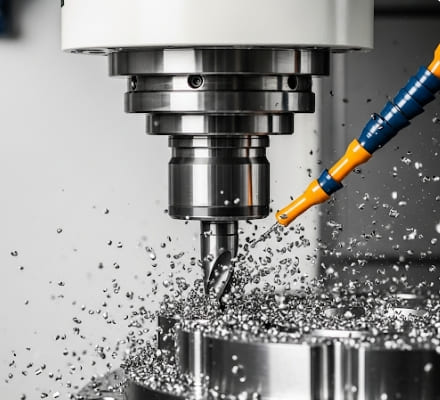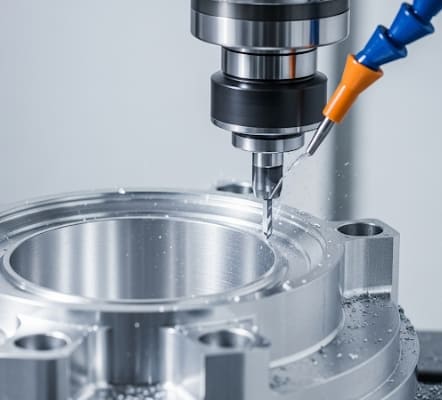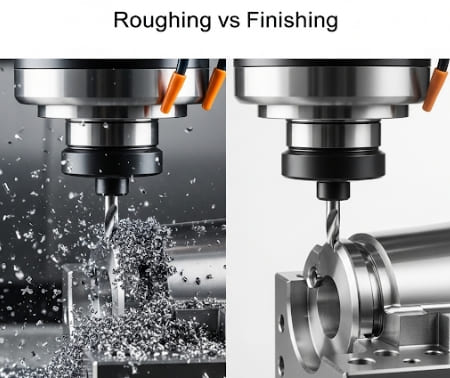Roughing vs Finishing: The Difference Between in CNC Machining
Facing challenges with inefficient machining or struggling to achieve the desired precision for your custom parts? Misunderstanding the distinct roles of roughing and finishing in CNC machining can lead to costly errors and subpar results. This article demystifies these two critical processes, empowering you to optimize your production.
Roughing rapidly removes the bulk of material, bringing the workpiece close to its final shape, while finishing meticulously refines the part to achieve high precision, superior surface finish, and exact final dimensions. These stages differ significantly in tooling, cutting parameters, machining strategies, and tolerance requirements, making their correct application crucial for successful CNC projects.
So, what exactly makes roughing and finishing so different, and why are they both essential for your project’s success? Let’s delve into each process.
What is Roughing in Machining?
Roughing is the foundational phase in CNC machining, primarily focused on removing large volumes of excess material from a raw workpiece quickly and efficiently. The main objective here is to get the part as close as possible to its net shape, leaving a minimal amount of material, known as the machining allowance or stock, for subsequent finishing operations. This stage prioritizes high material removal rates and operational efficiency over achieving final dimensional accuracy or surface finish.
Typically, large-diameter, multi-flute cutting tools with robust geometries are used in roughing. These workhorse tools are designed to withstand heavy cutting forces and efficiently evacuate chips, preventing re-cutting. Cutting parameters for roughing involve a large depth of cut, high feed rates, and medium to low spindle speeds. The machining strategy often includes large step-overs and aggressive cutting paths, sometimes utilizing step-down or plunge milling methods to remove material in layers. Roughing is commonly applied in scenarios like the initial shaping of castings or forgings, preparing them for more precise work. It’s a critical foundational step, significantly enhancing overall machining efficiency by rapidly reducing the volume of material that needs to be removed during the slower, more precise finishing stages. This initial rough milling pass ensures that subsequent precision operations are not overburdened.
What to Consider When Roughing in CNC Machining?
Roughing is the first major step in shaping a part, and doing it right makes the rest of the machining process smoother and more efficient. To get the best results, there are a few important things to keep in mind.
| Factor | What to Consider | Why It Matters |
|---|---|---|
| 1. Material Properties | Understand the hardness, toughness, and heat conductivity of the workpiece material. | Helps choose proper speeds, feeds, and tools to avoid tool damage and ensure efficient cutting. |
| 2. Tool Selection & Wear | Use roughing-specific tools (e.g., roughing end mills or inserts) and check them regularly for wear or chipping. | Ensures fast material removal and prevents tool breakage or poor part quality. |
| 3. Coolant & Chip Control | Ensure good coolant flow and proper chip evacuation during machining. | Reduces heat buildup, prevents chip re-cutting, and extends tool life. |
| 4. Machine Rigidity | Use a stable CNC machine setup with high rigidity and damping. | Prevents chatter during roughing cuts, ensuring smoother operation and better surface finish. |
What is Finishing Machining?
Finishing, in contrast to roughing, is the final, meticulous stage of CNC machining, dedicated to achieving the highest level of precision, desired surface quality, and exact final dimensions. The primary goals are to meet stringent tolerance requirements, produce a smooth machined finish, and ensure the part conforms precisely to the design specifications. This phase focuses on meticulous material removal, often just microns, rather than bulk volume.
For finishing operations, small-diameter, few-flute cutting tools, often with specialized coatings for enhanced wear resistance and reduced friction, are employed. These precision tools are designed for very fine cuts and minimal tool deflection. Cutting parameters are characterized by a small depth of cut, low feed rates, and high spindle speeds, which contribute to a superior surface finish and tighter dimensional control. The machining strategy for finishing involves small step-overs, fine cutting paths, and often multiple passes with very light cuts to gradually refine the part.
What to Consider When Finishing in CNC Machining?
Achieving a flawless and precise final part in CNC machining requires meticulous attention during the finishing phase. Several key factors must be carefully controlled to ensure optimal results.
| Factor Category | Description | Key Points |
|---|---|---|
| Accuracy & Tolerance Control | Finishing is where the part must meet final dimensional specs, often with tolerances as tight as 0.01 mm. | – Use high-precision measurement tools – Implement in-process probing for real-time feedback |
| Surface Finish Requirements | The desired finish affects tool geometry and cutting parameters. Mirror-like surfaces require special tools, high spindle speeds, and ultra-light passes. | – Use tools designed for fine finishes – Increase spindle speed, reduce feed and depth of cut |
| Finishing Tool Selection & Tool Life | Though less stressed than roughing tools, finishing tools must maintain sharp edges. Coatings can enhance durability and finish consistency. | – Maintain tool sharpness – Use coated tools for extended life and improved finish |
| Fine-Tuning Cutting Parameters | Small changes in feed rate, spindle speed, and depth of cut can greatly impact both surface quality and dimensional precision. | – Carefully optimize machining parameters – Base adjustments on machining feedback |
| Environmental Conditions | Temperature and humidity affect material expansion or contraction. Stable conditions are essential, especially for ultra-precise parts (e.g., atomic clocks). | – Maintain constant temperature and humidity – Avoid thermal drift in the machining zone |
Key Differences Between Roughing and Finishing in CNC Machining
Understanding the differences between roughing and finishing is essential for balancing efficiency with precision in CNC machining. Although both are fundamental stages of the same process, they serve very different purposes and require distinct strategies.
1. Roughing vs. Finishing: Objective & Purpose
The core purpose of roughing is to remove excess material as quickly and efficiently as possible to bring the workpiece close to its final shape, known as the near-net shape. Speed and volume are prioritized over accuracy.
In contrast, finishing is focused on refining the part to meet its exact design specifications. This includes achieving high dimensional accuracy and an excellent surface finish. It’s the final step that ensures the part is ready for use or assembly.
2. Roughing vs. Finishing: Tool Selection
Roughing typically uses large, robust tools such as indexable cutters, large-diameter end mills, or inserted face mills. These tools are built to withstand high cutting forces and are designed for fast chip evacuation.
Finishing, on the other hand, utilizes small-diameter, finely ground tools, often with more flutes for smoother cutting and specialized coatings like TiAlN to reduce wear and enhance surface quality. These tools are designed to maintain sharpness and minimize vibration during light cuts.
3. Roughing vs. Finishing: Cutting Parameters
Roughing operations employ deep cuts, high feed rates, and moderate spindle speeds to maximize material removal rate. Tool life and vibration are less of a concern at this stage.
Finishing requires the opposite: shallow cuts, slow feed rates, and high spindle speeds. This combination minimizes tool deflection, enhances control, and achieves superior surface finishes with high dimensional accuracy.
4. Roughing vs. Finishing: Material Removal Rate
Roughing is characterized by a high material removal rate, often using aggressive feeds and deep depths to clear bulk material quickly.
Finishing, however, focuses on low material removal with light cuts, not to remove material rapidly but to refine the surface and achieve exact dimensions.
5. Roughing vs. Finishing: Tolerances & Accuracy
During roughing, dimensional precision is not the goal. A machining allowance is intentionally left behind (usually 0.2–1 mm) for the finishing pass.
Finishing ensures the part meets tight tolerance requirements—often within ±0.01 mm or better—through careful, incremental material removal and consistent dimensional control.
6. Roughing vs. Finishing: Surface Quality
Roughing generally produces a rough surface with visible tool marks, burrs, or uneven features. Since surface quality isn’t the priority, aesthetics and fine details are ignored.
Finishing delivers a smooth, polished surface, sometimes mirror-like, depending on the tool geometry and parameters. This is crucial for functional parts, especially those in aerospace, medical, or optical industries.
7. Roughing vs. Finishing: Machining Strategy
Roughing strategies involve wide step-overs, aggressive passes, and simpler toolpaths that prioritize speed over finesse. Fewer toolpaths are used to get close to the part’s final shape.
Finishing strategies include multiple detailed passes with very small step-overs, especially around complex geometries. The toolpath is meticulously optimized to maintain consistent surface quality and dimensional accuracy.
8. Roughing vs. Finishing: Machine Tool Stability Requirements
During roughing, the machine can tolerate more vibration, as the process is less sensitive to slight inaccuracies or surface marks.
In finishing, however, machine rigidity and stability are essential. Even minor vibrations or thermal fluctuations can lead to dimensional errors, surface defects, or chatter marks that compromise the quality of the final part.
Summary Table: Roughing vs. Finishing
| Feature | Roughing | Finishing |
|---|---|---|
| Primary Goal | Rapid material removal, form near-net shape | High precision, fine finish, final dimensions |
| Material Removal Rate | High, aggressive chip load | Low, minimal chip load |
| Tool Type | Large, robust end mills or inserts | Small, precise tools with more flutes and coatings |
| Cutting Parameters | Deep cuts, high feed rate, moderate spindle speed | Shallow cuts, low feed rate, high spindle speed |
| Tolerance & Accuracy | Lower precision, rough dimensions | Tight tolerance (±0.01 mm), high dimensional accuracy |
| Surface Finish | Coarse, visible tool marks | Smooth, polished, fine finish |
| Machining Strategy | Broad toolpaths, aggressive material clearing | Fine, multi-pass toolpaths with light step-overs |
| Machine Stability Needs | Tolerant to some vibration | Requires high rigidity and minimal vibration |
VMT’s One-Stop CNC Machining Services
At VMT, with our 15 years of CNC Machining factory experience, we understand between roughing and finishing, offering a truly one-stop solution for all your precision machining needs. We’ve proudly produced more than 15000 parts, consistently meeting stringent quality demands across various industries. VMT is your trusted partner for high-precision metal and plastic CNC machining, delivering excellence from initial roughing to the perfect machined finish.
In Conclusion
Roughing and finishing are two distinct yet equally vital stages in CNC machining. Understanding their differences and optimizing each process is fundamental for achieving both production efficiency and superior product quality. VMT, with its advanced technology, experienced engineers, and stringent quality control, ensures your customized parts meet the highest standards, from the initial roughing to the final, precise details and perfect machined finish.
Frequently Asked Questions About Roughing and Finishing
Why Is the Material Removal Rate (MRR) Crucial in CNC Roughing?
MRR is critical in CNC roughing because it directly affects machining efficiency and production time. A high MRR helps remove bulk material quickly, reducing cycle time and cost. Optimizing MRR ensures effective roughing without overloading tools or machines, striking a balance between speed, accuracy, and tool life.
How Does CNC Roughing Affect the Lifespan of Machining Tools?
CNC roughing involves heavy cutting loads, which generate more heat and stress on the tool. If not properly managed, it can lead to faster tool wear, chipping, or even breakage. Using the right speeds, feeds, and cooling can reduce tool wear and extend lifespan during the roughing phase.
Why Is CNC Roughing Important?
CNC roughing is important because it quickly removes excess material to form the basic shape of a part. This prepares the workpiece for finishing operations, saving time and reducing tool stress. Efficient roughing improves workflow, reduces machining time, and enhances overall productivity in the CNC process.
What Is the Difference Between Rough Cut and Finish Cut?
A rough cut removes large amounts of material quickly with lower precision, while a finish cut focuses on achieving the final dimensions, surface quality, and tolerances. Roughing prioritizes speed and volume removal; finishing ensures accuracy and surface finish.
What Is the Difference Between a Roughing Mill and a Finishing Mill?
A roughing mill is designed to remove large volumes of material with high cutting forces, using fewer flutes and robust geometry. A finishing mill has more flutes and a finer edge to produce smooth surfaces and precise dimensions with lower cutting loads.
What Is the Difference Between Roughing and Finishing Inserts?
Roughing inserts are thicker, stronger, and designed to handle heavy cuts and material removal. Finishing inserts are sharper with finer geometries, allowing precise, smooth surface finishes. Each type is optimized for different stages of the machining process.






